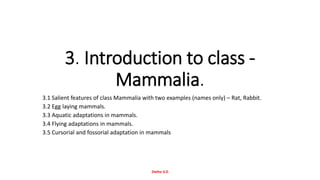
Class: General Characters, Mammals classification , Adaptation.
- 1. 3. Introduction to class - Mammalia. 3.1 Salient features of class Mammalia with two examples (names only) – Rat, Rabbit. 3.2 Egg laying mammals. 3.3 Aquatic adaptations in mammals. 3.4 Flying adaptations in mammals. 3.5 Cursorial and fossorial adaptation in mammals Dethe V.D
- 2. • Mammals are one of the most evolved in the vertebrata. • They are found all over and have adapted well to their surroundings. • Characterized by the presence of mammary glands which in females produce milk for feeding (nursing) their young, a neocortex (a region of the brain), fur or hair, and three middle ear bones.
- 3. Salient features of class Mammalia Mammals (from Latin mamma, 'breast') • Mammals possess mammary or milk glands, Sweat gland and Sebaceous gland. • Mammals are Homoeothermic animals. • Give birth to their younger ones.(Viviparous). • They have two pairs of limbs, adapted for walking, running, climbing, burrowing, swimming and flying. • The skin of mammals has hair or fur. • External ear or pinnae are present
- 6. • Presence of region of the brain known as Neocortex. • They are heterodont • Mammals also possess cervical vertebrae. • The skull is dicondylic.
- 8. • Heart is four chambered. The sinus venous and renal portal system are absent. • Blood red in colour (RBC,WBC) • Respiration is by lungs. • Muscular diaphragm separating the thorax and abdomen.
- 10. • The brain is well developed and divided into cerebrum, cerebellum and medulla. • 12 pairs of cranial nerves. Olfactory (CN I), Optic (CN II), Oculomotor (CN III), Trochlear (CN IV), Trigeminal (CN V), Abducent (or abducens; CN VI), Facial (CN VII), Vestibulocochlear (CN VIII), Glossopharyngeal (CN IX), Vagus (CN X), Accessory (CN XI), And hypoglossal (CN XII).
- 11. Kingdom:Animalia Phylum: Chordata Class: Mammalia Order: Rodentia Family: Muridae Genus: Rattus Species: R. rattus Kingdom:Animalia Phylum: Chordata Class: Mammalia Order: Lagomorpha Family: Leporidae Genus: Oryctolagus Species: Oryctolagus cuniculus https://en.wikipedia.org/
- 13. Egg laying mammals. • The mammals can lay eggs also. They are known as Monotrems. • Monotreme, (order Monotremata), • Member of the egg-laying mammalian order Monotremata, which includes the amphibious duck billed- platypus (family Ornithorhynchidae) and • the terrestrial echidnas (family Tachyglossidae)
- 15. Aquatic adaptations in mammals. • Types of Aquatic mammals. • 1. Completely aquatic mammals. • 2. Semi-aquatic or amphibious mammals.
- 16. Completely aquatic mammals. • live their entire life in the water. For Ex. Whales, Dolphins or manatees. They never come to land and are completely live in water Dolphins Blue whale Manatees
- 17. • Cetacea: Whales , dolphins , porpoises • Sirenia: Dugongs , manatees
- 18. Amphibious mammals • These mammals do not live permanently in water. They live on land but go into water for food and shelter. • seals, otters, and hippopotamuses etc.
- 19. Amphibious mammals ORDERS/Groups • Monotremata: Ornithorhynchus (Platypus) • Marsupialia: Chironectes • Artiodactyla: Hippopotamus • Pinnipidia: Walruses ,otters, seals , sea lions • Rodentia : Beavers , Musk rats
- 20. Adaptations in Amphibious mammals • Small external ears, • Flat tail. • Webbed feet, • Slender body • Elongated snout • Subcutaneous fat
- 21. Important Aquatic adaptations • Body shape: tapering and stream lined body. • Locomotory Organ: flipper (swimming paddles ), dorsal fin, tail flukes. • Integument: blubber (fatty layer of adipose tissue, loss of skin gland. • Skeleton Modification:Modification of skull bone, Cervical vertebrae are fused, Endoskeleton is light. • Lungs:Highly elastic & non lobular, allow the animal to stay under water for a longer period.
- 23. Physiological Adaptation 1. Thermoregulation 2. Feeding Habits 3. Osmoregulation 4. Growth and Size https://images.app.goo.gl/4uciJUjcQhBxaY7C6
- 24. Flying adaptations in mammals • Arboreal mammals are able to climb the trees and modes of aerial locomotion or flight-gliding, soaring and flapping. • Gliding : Adaptation: Limbs are long and equal, patagium (Skin Fold), streamlined body, Tapered Tail • Examples: https://images.app.goo.gl/HvUxaG1YoNf11u6r5 Phalangers Order Marsupialia Flying Squirrels Order Rodentia Flying lemurs Order Dermoptera
- 25. • Flying Mammals and Adaptations (Flapping) • Adaptation : Wings: patagia are thin with elastic membranes, The muscles and other body structures in bats to support and operate the wings, • Bats: Order Chiroptera https://images.app.goo.gl/Qqs4sW652YJAmCYE7
- 26. Cursorial and fossorial adaptation in mammals • Cursorial Adaptation: (limbs adapted for running).This is important for speed on hard surface • The body of cursorial animals is streamlined and spindle-shaped. • Loss of clavicle in mammals, which allows the scapula to move forwards and backwards with the limb and thereby increase stride length. • Increased limb bone length • Reduction or loss of digits. • Hooves, hoof-like claws, or blunt claws for traction
- 28. Fossorial adaptation Adapted for use in burrowing. • i. Animal digging the soil for food. e.g., elephant, swine, • ii. Animals digging for retreats but seek their food above the ground. e.g., fox, mongoose • iii. Animals digging for retreat but find their food under the ground. e.g., Rattus etc. • Body is fusiform or spindle shaped • Head is tapering, skull is conical (e.g., spiny ant-eater, moles and shrews). https://www.notesonzoology.com/
- 29. • Incisor Teeth: • The incisor teeth are upturned protruded and helps in digging in pocket gopher. The tusks in elephant also help in digging. • Canine Teeth: • In swine, canines are effective digging instrument and in others it becomes reduced. • Functions of the Limbs: • strong fore limbs is well suited for digging into the soil